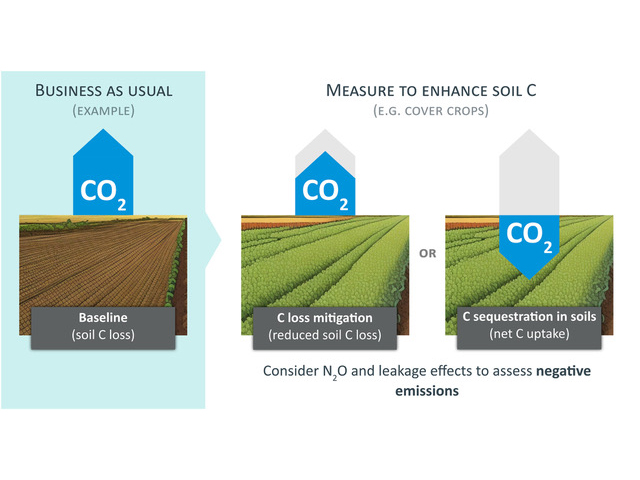Carbon storage, carbon sink - are they the same thing? And does fixing carbon in the soil, for example by building up soil carbon, automatically lead to more climate change mitigation? In the public discussion on climate change mitigation, many things get mixed up. Even in scientific publications on the subject, technical terms are not always used correctly. The latter is one of the findings of a recent study in which 100 international scientific publications were analysed. It is not just a matter of quibbling over words - imprecise wording can lead to inflated expectations of measures for climate change mitigation.
The focus of the study, which dealt with the "soil" system, was on the terms "C sequestration" and "negative emission". What is the difference? Carbon that escapes from soil is emitted into the atmosphere, i.e. as the greenhouse gas carbon dioxide (CO2). This emission isn't a one-way street, however, and atmospheric CO2 can be recaptured and bound in the soil in the form of soil carbon in a way that is not harmful to the climate. If, in the balance, more carbon from the atmosphere is fixed in the soil than is emitted, this is called C sequestration or negative emissions. Additional carbon must therefore be stored in the soil as soil carbon (carbon sink); it is not enough to simply maintain existing soil carbon stocks (carbon reservoir).
That's where using the correct terms is important: "Many croplands in Europe are currently losing soil carbon because of climate change or through unsustainable management," says Axel Don, a scientist at the Braunschweig-based Thünen Institute of Climate-Smart Agriculture and lead author of the study. Many measures to build up soil carbon on these areas will therefore only reduce, or at best stop, the loss of carbon for the time being. This does not lead to C sequestration, but "only" to a reduction in C loss. So no negative emissions can be generated here, because there is still greater emission of greenhouse gases than sequestration of CO2 by the formation of new soil organic matter. Nevertheless, it is still considered climate change mitigation if emissions have been reduced compared to before. However, only - and now it gets complicated in practice - if the measures do not cause additional greenhouse gas emissions elsewhere. This is the next important condition for assessing whether measures to build up soil carbon actually contribute to climate change mitigation or not. There are measures, e.g. reduced tillage, which can simultaneously increase emissions of the climate-damaging nitrous oxide from the soil. Because nitrous oxide has almost 300 times the effect on the climate as CO2, small additional amounts of nitrous oxide can destroy the climate change mitigation effect of a soil carbon building measure or even lead to more greenhouse gases overall.
So if you want to assess what climate impact a certain soil carbon-building measure has, you have to take all greenhouse gas emissions into account. Otherwise, there is a danger of drawing completely wrong conclusions. If all greenhouse gas effects of a measure are added up and more greenhouse gases are taken up by the soil than emitted, we speak of "negative emissions”.
Analysis of 100 recent scientific publications on the topic of C sequestration in soils has shown that the vast majority use the terms around C sequestration incorrectly or ambiguously. The new Thünen publication clarifies the definitions and differences between the terms C sequestration, negative emissions, climate change mitigation and soil carbon build-up, and potential pitfalls. The aim is to improve communication between the various stakeholders from science, politics, business and society in order to better assess the climate change mitigation contribution through soil carbon build-up.
The study, which has now been published in the journal Global Change Biology, was prepared by Axel Don and his team at the Thünen Institute and an international co-author collective as part of the EU's EJP Soil programme. It is published here: https://onlinelibrary.wiley.com/doi/10.1111/gcb.16983








